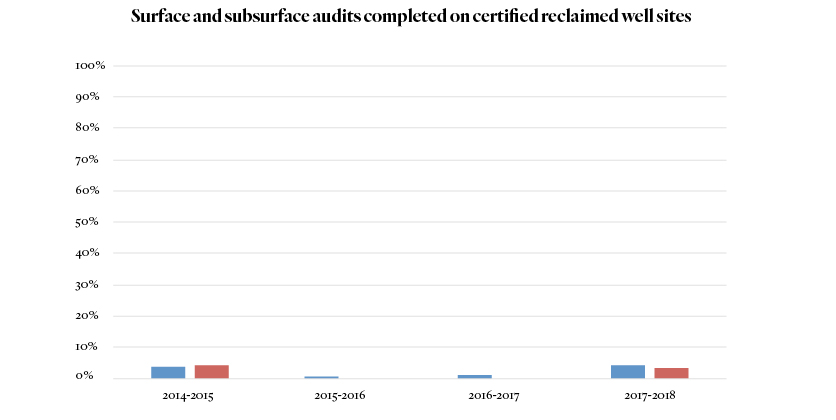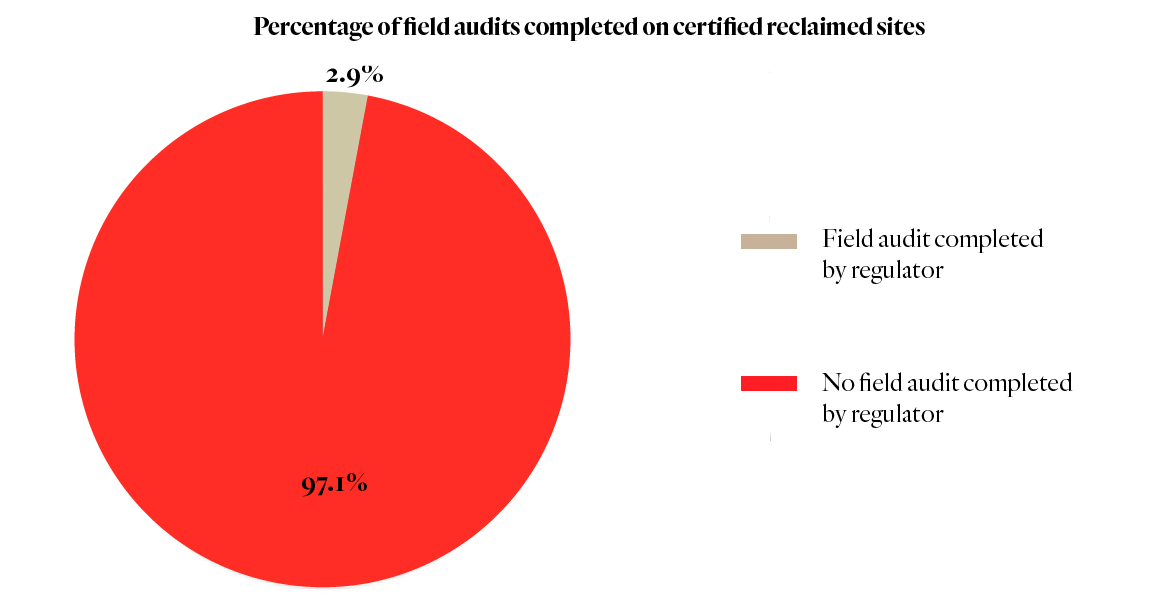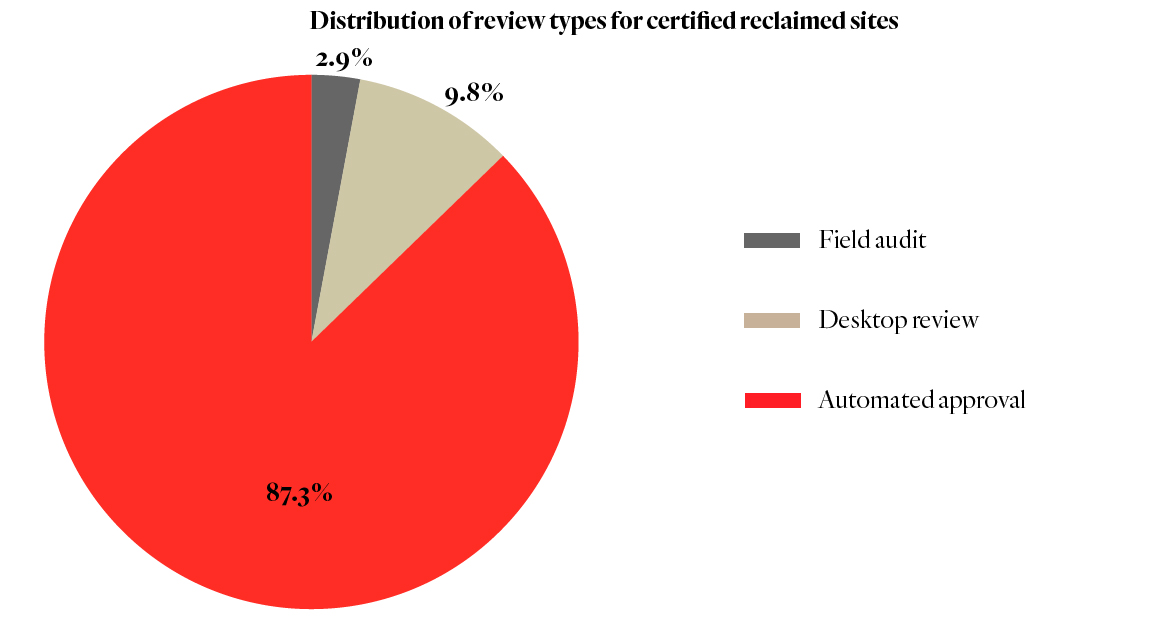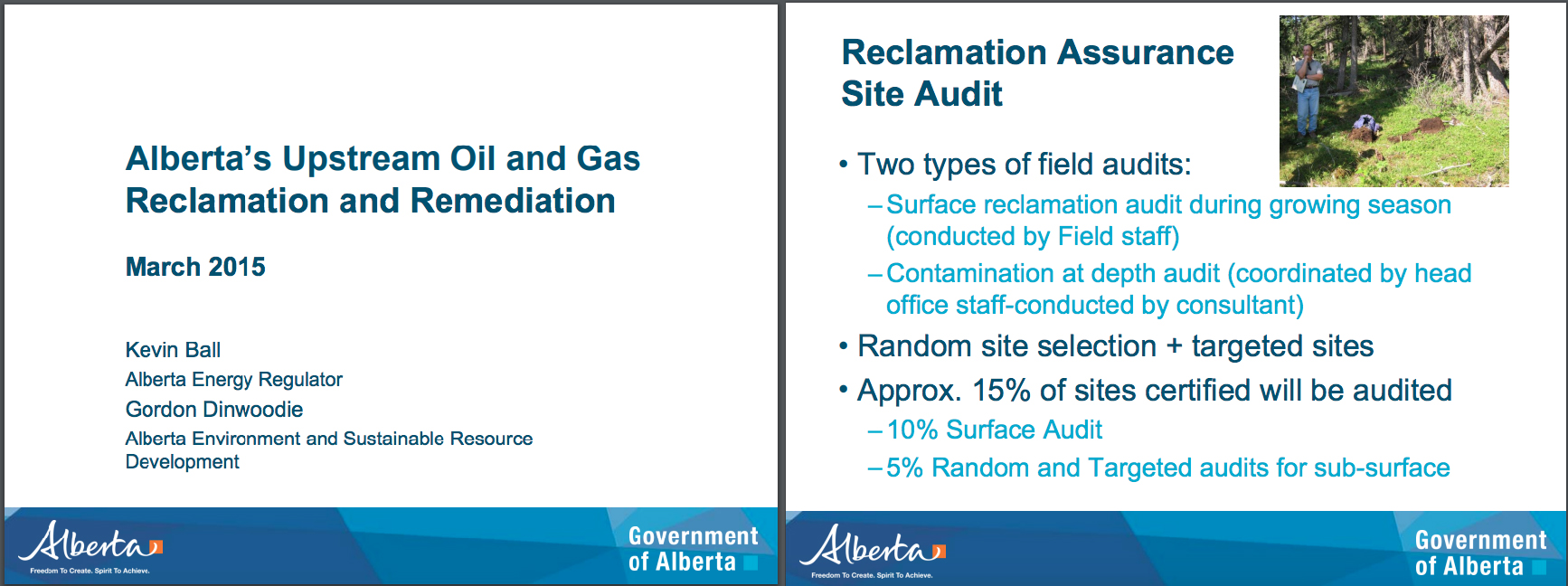
Hope for a huge, ancient and imperilled fish
First Nations are leading efforts to make sure lake sturgeon can find a home in...
Documents obtained by The Narwhal reveal that, for the last four years data is available, 2014 – 2018, less than three per cent of oil and gas sites certified as reclaimed have been visited by an inspector from the provincial regulator — a far cry from the 15 per cent the public has been long told.
The data — accessed through a lengthy back-and-forth with the Alberta Energy Regulator’s media team and freedom of information office — shows that since the spring of 2014, more than 9,400 reclamation certificates have been issued, but during that same time period, just 277 sites were actually visited by the regulator for an audit.
This means the vast majority of oil and gas sites are certified as reclaimed without any independent physical assessment by the regulator — and most reclamation certificates are granted by an automated system.
This wasn’t always the plan.
In a 2014 report, the Government of Alberta noted there are “randomly selected field audits on approximately 15 per cent of all sites that have received a reclamation certificate.”
And at a 2015 landowner oil and gas information workshop, government and regulator officials — including Kevin Ball, senior advisor with the Alberta Energy Regulator — told participants that 15 per cent of sites are visited for a field audit.
But this is certainly not the case under the Alberta Energy Regulator, which oversees the certificate program today.
The Alberta Energy Regulator took over handling reclamation certificates from Alberta Environment in 2013. It launched an automated approval system online, called OneStop, in 2016.
Though the audit system is often understood as a way for the regulator to go out into the field to assess the work of the contractor who applied for the reclamation certificates, it has largely come to mean a human eye looking at an application’s details, and has rarely entailed a visit to site.

The percentage of certified reclaimed sites where the regulator completed a surface or subsurface audit between 2014 and 2018. In 2015, the regulator and the government told landowners 15 per cent of sites would be visited for a field audit. In reality, less than three per cent of sites have been visited. Graph: Sharon J. Riley, Carol Linnitt / The Narwhal
When The Narwhal started looking into this issue last fall, the Alberta Energy Regulator initially told us by email that “84 per cent or 1767 of the 2093 issued reclamation certificates were audited” in fiscal year 2017/2018.
When pressed, a spokesperson changed the number. “We discovered that the number provided was incorrect,” she said in an email.
“The [Alberta Energy Regulator]’s audit program flags 15-30 per cent of reclamation certificates for desktop, surface, or subsurface audits,” a spokesperson for the regulator then told The Narwhal by email last fall.
More recently, the regulator told The Narwhal by email that, “on average, 15-20 per cent of reclamation certificates are flagged for desktop, surface, or subsurface audits.”
Either way, none of these statements accurately capture what’s been going on over the most recent four years of data available.
Data shows that 12.7 per cent of approvals have involved any kind of audit at all over the most recent four years data is available, 2014 to 2018. Of those audits, the vast majority are simply a human review of the paperwork, a procedure called a “desktop review” that was introduced in 2016.

Less than three per cent of sites that have received reclamation certificates from the Alberta Energy Regulator have been visited as part of an audit of the site’s approval, which is largely automated (2014-2018). The public has frequently been told 15 per cent of sites would be visited for an audit. Graph: Sharon J. Riley, Carol Linnitt / The Narwhal
Field visits are much more rare.
Since taking responsibility for regulating reclamation, the highest number of sites visited by the regulator in the province in one year is 117, while between 1,110 and 4,500 certificate have been approved annually.
In fiscal year 2015/2016, just seven sites were visited for an audit, while 1,184 were issued reclamation certificates.
Even fewer sites involve what’s known as a subsurface audit, which involves looking below the surface of the site and collecting soil samples for lab analysis.
In 2015, officials told landowners that five per cent of sites would receive a subsurface audit.
In reality, just over one per cent of reclamation certificates have involved a subsurface audit in recent years.
Between 2015 and 2017, not a single subsurface audit was conducted, while nearly 6,000 reclamation certificates were approved.
The regulator cites “budget constraints” as the reason for not conducting any subsurface audits in those years.
The Alberta Energy Regulator is an independent corporation funded entirely by industry. It is mandated by the provincial government to oversee regulation of oil and gas activities in Alberta.
A spokesperson says the program was in a “state of transition” and that it has only been auditing under its current system for one year (five per cent of sites were visited for any kind of field audit last year). Thirty-six per cent of reclamation certificate applications were audited — the vast majority of which were desktop reviews — last year, up from five per cent in 2016-2017.
The rest were approved by the regulator’s automated system.

The vast majority of reclamation certificates in Alberta are approved via an automated system and never audited by the regulator (2014-2018). Sharon J. Riley, Carol Linnitt / The Narwhal
Up until 2003, Alberta’s reclamation program involved field visits to every site applying for a reclamation certificate. Government inspectors would head out to former wellsites to make sure clean-up efforts met government standards.
That all changed in 2003, when the government moved to an audit system, with a spokesperson
telling The Globe and Mail at the time that random field audits would help ensure compliance, and that the province planned to audit 15 per cent of the sites.
In 2003, 14 people gathered around a long conference table to talk about the future of reclamation certificates in Alberta. They were the Oil and Gas Remediation and Reclamation Advisory Committee, created to provide recommendations to the minister on the new system that had just been designed to “enhance capacity needed to deal with an increasing workload” — in other words, they were overwhelmed with applications for reclamation certificates.
Some committee members were representatives of Alberta Environment, the Surface Rights Federation, the Farmers’ Advocate and the Energy and Utilities Board, among others. Two representatives were there on behalf of the Canadian Association of Petroleum Producers (CAPP).
Peter Eggers, a director with the National Farmers Union who farms near La Glace, Alta., was there, too. He was representing the Alberta Conservation Tillard Society.
Eggers had had his own problems with a certified reclaimed well pad on his property — he told The Narwhal that the Orphan Well Association had paid for its cleanup, and removed thousands of tonnes of soil. Still, Eggers said, the quality of the site has never been the same. His neighbour, he told The Narwhal, refers to the certified reclaimed well pad as “the spot where nothing grows.” It’s been a long-standing headache.
Eggers was interested in the reclamation certificate process, and was optimistic he’d be able to have input. “People said the oil companies were dictating how things would happen,” he remembers.
He wanted to find out for himself.
Eggers told The Narwhal he was paid an $8 per diem to attend the meetings in Edmonton. The purpose, he says, was to develop a way to “streamline” the process through which companies could receive reclamation certificates.
On the final day, Eggers told The Narwhal, the CAPP delegates sat at one end of a long conference table, Alberta Environment representatives at the other. The two parties, Eggers said, looked only at each other. Other participants watched from the sidelines, literally.
“The CAPP people were dictating to the [Alberta] Environment people” he said. “The CAPP people would always kind of put their fist down.”
“The rest of us were there just for the alibi.”
The end result, according to Eggers, is a “bingo-dauber agency” — now the Alberta Energy Regulator — that approves reclamation certificates without what he considers to be sufficient regulatory monitoring.
“It’s an agency that supposed to appear to the public that they have really good oversight,” he said.
“But it lets sites slip through the cracks.”

Active wells near Hays, Alta. Photo: Theresa Tayler / The Narwhal
The Alberta Energy Regulator’s annual report advertises that the majority of applications are approved using its automated system, OneStop, boasting that at one point 2,100 reclamation certificates (which it deemed “low-risk”) were processed “within a matter of hours” — no human oversight, no field visit, no inspection of the land or soil’s condition.
In Eggers’ committee’s recommendations to the minister in 2004, it was made clear that 15 per cent of all reclamation certificates were to be audited, and that an audit would involve a “field investigation component,” including the possible use of soil sampling equipment or laboratory analysis — a far cry from a desktop review.
At some point, the 15 per cent standard was apparently dropped, and the “field” was dropped from “field audit.” Prior to the introduction of “desktop audits,” all audits involved a field visit.
Eggers is clear that this is not how the program was initially intended to function: “An audit is also a site visit to verify that the written report and the actual condition [of the site] matches,” he said.
When asked for comment, the Alberta Energy Regulator responded to questions by email.
When The Narwhal asked if there had ever been a public announcement of this shift from field audits to primarily desktop audits, we were pointed toward a brief announcement unveiling OneStop. There is no mention of field audits.
“The [Alberta Energy Regulator] does not have a specific audit target for reclamation certificates,” Samantha Peck, a spokesperson for the regulator, wrote to The Narwhal.
“Our audit program was revised in 2016 and now uses statistics and confidence intervals to determine the number of audits that will be conducted within a given period,” Peck continued.
“[The Alberta government] does not provide direction or guidelines on the percentage of audits completed by the [Alberta Energy Regulator],” Peck said by email.

Slides from a Government of Alberta and Alberta Energy Regulator presentation delivered to landowners that indicates 15 per cent of oil and gas sites receiving reclamation certificates would be audited.
Peck referred The Narwhal to Alberta Environment and Parks for answers to questions about previous public commitments to conduct field audits at 15 per cent of sites.
The Narwhal first requested an interview with the Alberta Environment and Parks land reclamation policy team about this topic on Feb. 6.
After following up on Feb. 14, Feb. 15, Feb. 27, March 1, March 4, March 9, March 11 and March 19 — including sending questions by email, as requested — The Narwhal was told that the communications team was “not able to get the messages through approvals before the election was called… Sincere apologies.”
There are tens of thousands of inactive wells on the landscape, and the number has been growing every year.
Unlike in other jurisdictions, such as in parts of the United States, there are no required timelines in Alberta as to when a company has to clean up a site. It becomes a calculation — costs versus benefits for the company.
Once a company does decide to invest in cleanup, obtaining a reclamation certificate removes the liabilities it keeps on its balance books, and relieves it of the obligation to pay rent to the landowner where the pipeline or well is located
“Reclamation is not always simple or cheap,” Regan Boychuk of Reclaim Alberta told The Narwhal by email. “Auditing is crucial in order to protect Albertans from long-lasting risks and consequences.”
“Issuing certificates on the basis of paperwork without verification in the field creates perverse incentives for industry to forego expensive remediation and instead gamble it will ever be uncovered,” he said.
“Regulators have repeatedly chosen to prioritize industry’s interests over the health and safety of Albertans and their environment.”
The Alberta Energy Regulator points out that its automated approvals allow it to focus more energy on what it deems to be high-risk applications.
“To improve efficiency, the [regulator] is focused on improving application turnaround timelines, ensuring modern, effective requirements, and continuing to transform how we operate in order to keep up with market and technology changes that affect industry,” a spokesperson for the Alberta Energy Regulator told The Narwhal by email last fall.
Peck, a regulator spokesperson, told The Narwhal that it maintains that it “continually refines its reclamation certificate program to ensure the [Alberta Energy Regulator]’s mandate can be met, requirements remain effective, and assessment rules remain relevant.”
The Narwhal previously reported that the number of field inspectors has declined by 16 per cent since the Alberta Energy Regulator took over from Alberta Environment in 2013.
Whether audits are necessary at all is up for debate.
The current system requires that an accredited professional — an agrologist, a forester, an engineering technologist or similar —contracted by the company, signs off on a reclamation certificate application before it is submitted to the Alberta Energy Regulator.
For some, that professional assurance is enough — professionals could lose their accreditation if they sign off on subpar reclamation efforts — but for others, regulatory oversight is necessary, and even professionals need to know their work may be checked.
As one professional who spoke to The Narwhal last fall on the condition of anonymity put it, the company a contractor is evaluating a site for is also “going to be signing off on [their] invoice.”
Numerous contractors told The Narwhal there can be pressure to pass sites.
David Lloyd, CEO of the Alberta Institute of Agrologists — whose members are among the professionals contracted by companies to sign off on reclamation certificate applications — told The Narwhal by email that, “unless the professional body has specific practice standards in place related to a specific activity (like reclamation or remediation) and unless the profession is conducting a practice review of their members related to that practice standard, governments, I believe, should be auditing all professions equally and fairly.”
“If professions are not conducting practice reviews of their members, then how is the profession and the public to know that work is being done to a defined standard?” he asked.
The Alberta Institute of Agrologists has recently begun conducting its own random practice reviews — completing eight in December — and plans to resume in the fall.
Lloyd told The Narwhal that he isn’t aware of any other professional organizations involved in signing off on reclamation certificates in the province doing something similar.
The Narwhal reported last fall that a pilot project from Alberta Environment and Parks found that the vast majority of certified reclaimed sites studied were not meeting the government’s own standards for “equivalent land capability,” with lingering impacts on soil, plant and crop quality.
Eggers is skeptical that Alberta’s reclamation certificate program is working as it was intended, especially without on-the-ground audits being conducted regularly by the regulator.
“In our experience,” he said, “[companies] always try to get away with as much as they can.”
Get the inside scoop on The Narwhal’s environment and climate reporting by signing up for our free newsletter. Angello Johnson’s shoulders burn, and his arms...
Continue reading
First Nations are leading efforts to make sure lake sturgeon can find a home in...

We’re excited to share that an investigation by The Narwhal is a finalist for the...

A new documentary, Nechako: It Will Be a Big River Again, dives into how two...
